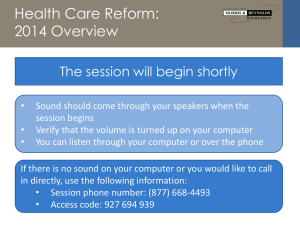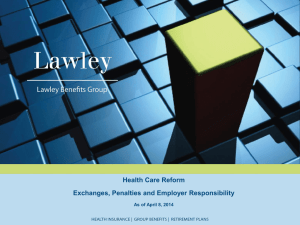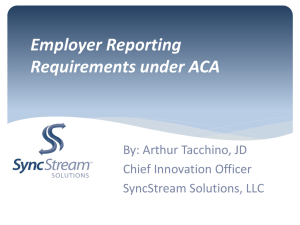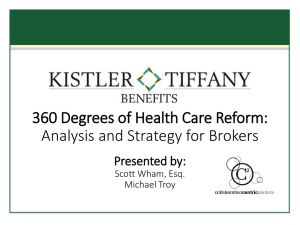Implementing Health Care Reform in the Workplace
advertisement
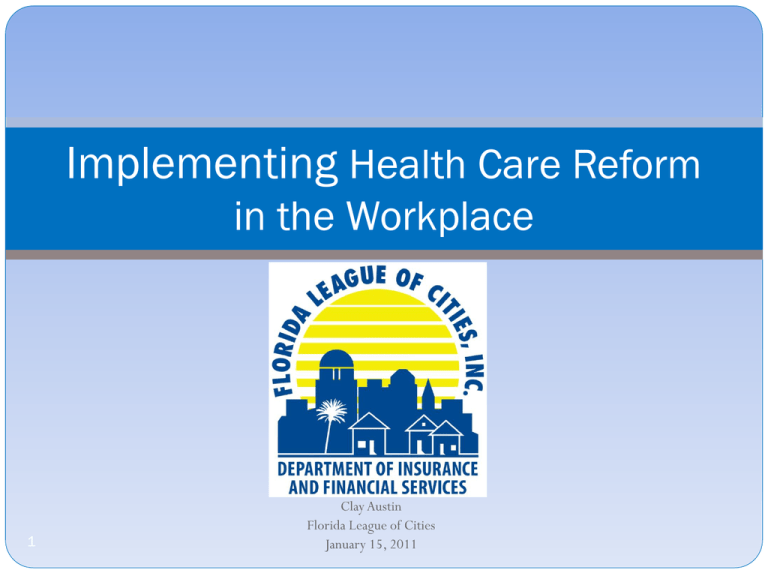
Implementing Health Care Reform in the Workplace 1 Clay Austin Florida League of Cities January 15, 2011 Health Care Reform Laws: Far Reaching and Complex Patient Protection and Affordable Care Act (PPACA) and Health Care and Education Reconciliation Act (HCERA) will change the health care landscape in the coming years as it becomes fully implemented Laws dramatically impact employer-sponsored group health plans Both fully-insured and self-funded plans Health reform laws are difficult to interpret and additional guidance is needed on almost every provision Key questions include: When and how must I comply with the new laws? How will this affect short, medium and long-term costs? How much latitude and flexibility will an employer have in designing and delivering benefits? What administrative challenges will the new law present? Health Care Reform: Government Plans Reform law indicates that city and county plans cannot opt out of reform provisions Previously opt out has been available to self-funded government plans for many other group health plan standards (HIPAA portability, mental health parity …) Big ticket items for government plans Dependent coverage to age 26 Collective bargaining extension Benefit mandates Early retiree reinsurance program 30 hr work week “Cadillac” plan tax Health Care Reform THESE PROVISIONS CAN CHANGE – A LOT IS UNCERTAIN AND WILL BE SUBJECT TO REGULATIONS/GUIDANCE. WILL BE NECESSARY TO FOLLOW – WATCH FOR EDUCATIONAL/REGULATORY INFORMATION RELEASED AS IT BECOMES AVAILABLE. MONITOR STATE AND FEDERAL INITIATIVES FOLLOWING PPACA 4 Health Care Reform Discussion about obligations as employers. What is required when? What do we know now? Discussion about obligations as individuals. What are the key changes. 5 Health Care Coverage Timeline Most changes occur in 2014 to expand coverage: Reform insurance marketplace (“Exchange”); Create tax credits; or Medicaid eligibility for low-income who do not have access to employer-sponsored coverage. Some interim changes in 2011. Gives time to make changes. 6 General Structure of Reform Most Americans stay in their employer-sponsored plans. Individuals and small groups may purchase coverage through the state-based exchanges in 2014. (An exchange is a group of insurance plans with new rules.) Tax credits for low-income individuals available only when coverage is purchased through the exchange. Between now and 2014, some changes to health insurance and employer-sponsored plans. 7 Past Changes in 2010 Minimum medical loss ratios $250 rebate for seniors for coverage through the Medicare Part D gap or “donut hole.” Tax credits for small employers. Early Retiree Reinsurance Program (ERRP) 8 Minimum Medical Loss Ratios Applies to all insured (but not self-insured) group health plans 85% if employer has > 100 employees 80% if employer has < or = 100 employees Proposed legislation over exclusion/inclusion of broker/agent commissions and fees still continues Early Retiree Reinsurance Program Reimburse up to 80% of claims between $15,000 and $90,000 (indexed) for each non-Medicare-eligible early retiree age 55 or older (and dependents) Set to end earlier of: when limited $5 billion runs out or Jan. 1, 2014 − First-come, first-served Sponsors must maintain their level of effort in supporting the plan − Applications will require explanation of how payments will be used to keep participant contributions down Eligible plans must have policies and procedures to generate cost savings with respect to individuals with high-cost conditions (those likely to incur $15,000 or more in claims during a plan year) Collectively Bargained Coverage If ratified prior to March 23, 2010, PPACA’s coverage and cost-sharing mandates apply on the termination date of the last CBA relating to health coverage Any amendments to comply with mandates will not terminate the CBA Collectively bargained plans may get a postponement, but not a permanent exemption Present Changes in 2011 (calendar year plans) Insurance & Employer-Sponsored Plans Must: Cover dependents up to age 26 (if plan offers dependent coverage); No lifetime limits (e.g. no limit on the spending under the plan); No restrictive annual limits on essential benefits; No rescissions (unless there is fraud); and No cost sharing on certain prevention and wellness benefits (unless plan is a grandfathered plan); and No pre-existing condition limitations on children 19 and younger. Additional Changes: W-2 reporting; HSA penalty; Changes to FSAs; CLASS Act enrollment begins. 12 Changes in 2013 Notice to employees about benefits and eligibility for exchange (March 1, 2013). Medicare payroll and unearned tax increased for certain individuals (no change to employer contribution). Limit on FSAs ($2,500). 13 Changes Starting on January 1, 2014 The beginning of the real changes Individual obligation to have coverage or pay a penalty. Employer obligations go into effect – auto-enrollment (over 200 employees), to offer affordable coverage or may pay a penalty. The Exchange will begin – this means there will be a selection of insurance plans for individuals and small groups under 100 to select from in each State. Exchange plans will meet the “essential benefit package,” guarantee issue, no pre-ex, rating limits, no more than 90 day waiting period, no annual limits, appeals and grievances, and other requirements. All other plans must meet 60% value test, guaranteed issue, no pre-ex, no more than 90 day waiting period, no annual limits, appeals and grievances, dependant coverage up to age 26, and other requirements. 14 Individual Obligation - 2014 Individual must obtain coverage through: Medicare; Medicaid; Eligibility expanded to all individuals with incomes up to 133% FPL (under age 65) Exchanges; Individual Small Groups (up to 100) Employer-Sponsored Coverage; Or pay a penalty 15 Low-Income Americans without Employer Coverage (in 2014) If an individual/family does: not receive employer sponsored coverage and earns between 133-400% of the federal poverty level, then the individual/family will get a tax credit to pay for all or part of their health insurance coverage. The tax credit can only be used in the exchange. 16 Employer Obligation Effective 2014 Employers may either offer coverage or pay a penalty. Coverage is only required for full-time employees (working more than 30- hours/week measured over a month). Coverage must be a plan that pays out 60% of the benefits. Coverage must be “affordable” for full-time employees, or full-time employees may get coverage in the exchange and may qualify for a tax credit. 17 If Employer Offers Coverage That is Not Affordable If the full-time employee must pay more than 9.5% of income for premium costs, the plan may be deemed “unaffordable” and employee may opt out and receive a tax credit for coverage in the exchange. If the full-time employee qualifies for a tax credit, employer will pay $3,000 penalty (or $2,000 for all full-time employees, whichever is less). 18 But Employer Does Not Have to Offer Coverage: For part-time workers; For seasonal/temporary workers; For full-time workers during a 90 day waiting period. 19 Example Employer offers coverage to all 230 full-time employees (and dependants). Coverage is unaffordable for 40 full-time employees. These 40 full-time employees get tax credits to buy coverage in the exchange. (no payment for first 30 full-time employees) Employer must pay $120,000, the smaller penalty. 20 $3,000 x 40 FT employees receiving tax credit = $120,000; verses $2,000 x (230-30) 200 FT employees = $400,000. If Employers Do Not Offer Coverage For employers not offering coverage to full-time employees (30 hours/week for a month) (and their dependents): If one full-time employee gets a tax credit to buy insurance in exchange: Employer must pay a fee $2,000 x # of all full-time employees (minus 30 full-time employees). EXAMPLE: Employer with 230 full-time employees does not offer coverage. 40 full-time employees get government tax credit to buy coverage in the exchange. Employer must pay: $2,000 x (230-30) 200 = $400,000. 21 Employer Does Not Have to Offer Coverage to: Part-time employees; Seasonal or temporary workers; or New employees during a 90 day waiting period. 22 Aggregating Employees Among 2 or More Employers Employer obligation to provide insurance only applies to the “applicable large employer,” with 50 full-time equivalent employees. Law incorporates IRC provisions on “common control” to determine when 2 or more employers treated as a single employer for purposes of determining whether 50 employee threshold met. In cases where 2 or more employers treated as a single employer, the 30 employee reduction for the purpose of calculating any penalty applies only once, and is allocated among employers based on their contribution of employees. 23 Always Some Exceptions: Small employer exception 50 full-time equivalencies (must add up all part-time workers when calculating number of employees for this exception). First 30 full-time workers exempted from aggregate penalty. “VOUCHER” If an employee’s premium contribution is between 8-9.5% of income, then employee may take the employer’s contribution to the exchange to purchase coverage. 24 QUESTIONS & SPECIFICS 25 Do I have to offer affordable coverage if some of my employees are eligible for Medicaid? Yes, otherwise you may still pay a penalty. Penalty would ONLY be for those full-time employees who are eligible for a tax credit. (Those between 133-400% of federal poverty limits.) No penalty for those eligible for Medicaid. More information will be provided about employees who are eligible for Medicaid. 26 How do you define “employer”? For the employer obligation requirement, an applicable large employer is one with 50 full-time equivalent employees. Law stipulates how employer size and full-time equivalents are calculated. Under current rules, generally employees who are “similarly situated” are covered under the same “plan.” Many times, employers will have more than one “plan,” like a plan for salaried workers and a plan for hourly workers. We do not know whether that will change. HOWEVER, there are rules prohibiting discrimination in favor of highly compensated individuals. 27 Do I have to offer coverage to parttime workers?” No. In 2014, employers must offer coverage to their full-time workers (30 or more hours per week measured over one month) or pay a penalty if any full-time workers qualify for a tax credit through the Exchange. 28 No penalty for first 30 full-time workers If offer coverage and it is unaffordable, or If do not offer coverage… Employer only pays penalty for those full-time workers (over the first 30) who receive tax credits to purchase coverage in the exchange. 29 Calculating Employer Size for Small Business Exception To qualify for exception, employer must have 50 or fewer full- time equivalent (FTE) employees. This is calculated by adding hours worked by all employees: Total # of hours of service for which wages were paid = ?* 2,080 *The resulting number is rounded to the next lowest whole number. Special aggregation rules apply for calculation of employees when 2 or more businesses treated as 1 business under IRC “common control” provisions. 30 An Unaffordable Plan? If the cost of the plan to the employee exceeds 9.5% of that employee’s income, The plan may be deemed “unaffordable” and The employee may opt out and receive a tax credit for coverage in the exchange. Then, employer will have to pay a penalty. 31 SNAPSHOT – More to come This new law is a work in progress. There is potential for change – however, certain requirements go into effect for a “plan year that begins 6months after date of enactment.” Monitor state/federal initiatives following PPACA. 32 Clay Austin Director of Group Health Florida League of Cities 407-367-3432 caustin@flcities.com





